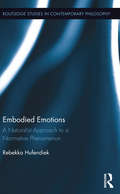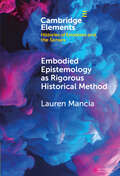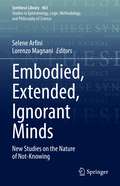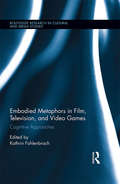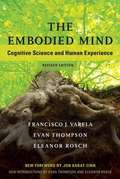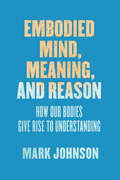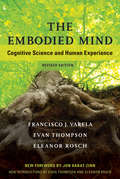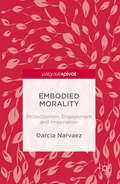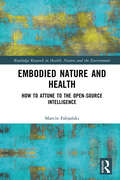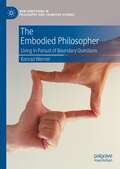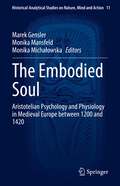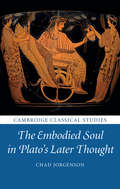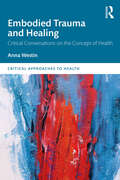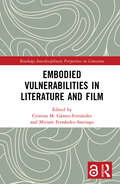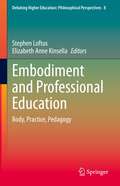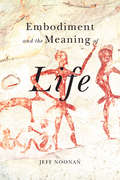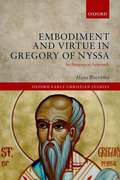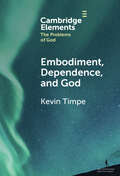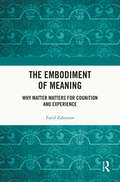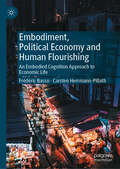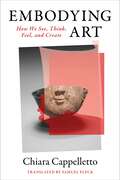- Table View
- List View
Embodied Emotions: A Naturalist Approach to a Normative Phenomenon (Routledge Studies in Contemporary Philosophy)
by Rebekka HufendiekIn this book, Rebekka Hufendiek explores emotions as embodied, action-oriented representations, providing a non-cognitivist theory of emotions that accounts for their normative dimensions. Embodied Emotions focuses not only on the bodily reactions involved in emotions, but also on the environment within which emotions are embedded and on the social character of this environment, its ontological constitution, and the way it scaffolds both the development of particular emotion types and the unfolding of individual emotional episodes. In addition, it provides a critical review and appraisal of current empirical studies, mainly in psychophysiology and developmental psychology, which are relevant to discussions about whether emotions are embodied as well as socially embedded. The theory that Hufendiek puts forward denies the distinction between basic and higher cognitive emotions: all emotions are embodied, action-oriented representations. This approach can account for the complex normative structure of emotions, and shares the advantages of cognitivist accounts of emotions without sharing their problems. Embodied Emotions makes an original contribution to ongoing debates on the normative aspects of emotions and will be of interest to philosophers working on emotions, embodied cognition and situated cognition, as well as neuroscientists or psychologists who study emotions and are interested in placing their own work within a broader theoretical framework.
Embodied Epistemology as Rigorous Historical Method (Elements in Histories of Emotions and the Senses)
by Lauren ManciaThis Element proposes that, in addition to using traditional historical methodologies, historians need to find extra-textual, embodied ways of understanding the past in order to more fully comprehend it. Written by a medieval historian, the Element explains why historians assume they cannot use reperformance in historical inquiry and why they, in fact, should. The Element employs tools from the discipline of performance studies, which has long grappled with the differences between the archive and the repertoire, between the records of historical performances and the embodied movements, memories, and emotions of the performance itself, which are often deemed unknowable by scholars. It shows how an embodied epistemology is particularly suited to studying certain premodern historical topics, using the example of medieval monasticism. Finally, using the case of performance-lectures given at The Met Cloisters, it shows how using performance as a tool for historical investigation might work.
Embodied, Extended, Ignorant Minds: New Studies on the Nature of Not-Knowing (Synthese Library #463)
by Selene Arfini Lorenzo MagnaniThis book offers a new and externalist perspective in ignorance studies. Agnotology, the epistemology of ignorance, and, more generally, ignorance studies have grown to cover and explore different phenomena and subjects of research, from known events in history and sociology of science to the investigation of ordinary reasoning and cognitive processing. Nonetheless, although interested scholars have discussed ignorance phenomena and their impact on cognition, most of them have only adopted an internalist perspective to approach this theme. Meanwhile, even though externalist perspectives on cognition flourished in recent literature, authors have paid little attention to the emerging field of ignorance studies. Ignorance has been generally left out from the inquiries on the extension of cognitive states, cognitive processes, and predictive reasoning. Thus, in this volume, we seek to merge the two growing areas of research and to fill this research gap fruitfully. By addressing the uncomfortable themes that pertain to ignorance and related phenomena through an externalist perspective, this book aims to provide much food for thoughts to cognitive scientists and philosophers alike, enriching the current range and reach of both ignorance studies and externalist approaches to cognition.
Embodied Metaphors in Film, Television, and Video Games: Cognitive Approaches (Routledge Research in Cultural and Media Studies)
by Kathrin FahlenbrachIn cognitive research, metaphors have been shown to help us imagine complex, abstract, or invisible ideas, concepts, or emotions. Contributors to this book argue that metaphors occur not only in language, but in audio visual media well. This is all the more evident in entertainment media, which strategically "sell" their products by addressing their viewers’ immediate, reflexive understanding through pictures, sounds, and language. This volume applies cognitive metaphor theory (CMT) to film, television, and video games in order to analyze the embodied aesthetics and meanings of those moving images.
The Embodied Mind: Cognitive Science and Human Experience
by Eleanor Rosch Evan Thompson Francisco J. Varela Jon Kabat-ZinnThis classic book, first published in 1991, was one of the first to propose the "embodied cognition" approach in cognitive science. It pioneered the connections between phenomenology and science and between Buddhist practices and science -- claims that have since become highly influential. Through this cross-fertilization of disparate fields of study, The Embodied Mind introduced a new form of cognitive science called "enaction," in which both the environment and first person experience are aspects of embodiment. However, enactive embodiment is not the grasping of an independent, outside world by a brain, a mind, or a self; rather it is the bringing forth of an interdependent world in and through embodied action. Although enacted cognition lacks an absolute foundation, the book shows how that does not lead to either experiential or philosophical nihilism. Above all, the book's arguments were powered by the conviction that the sciences of mind must encompass lived human experience and the possibilities for transformation inherent in human experience. This revised edition includes substantive introductions by Evan Thompson and Eleanor Rosch that clarify central arguments of the work and discuss and evaluate subsequent research that has expanded on the themes of the book, including the renewed theoretical and practical interest in Buddhism and mindfulness. A preface by Jon Kabat-Zinn, the originator of the mindfulness-based stress reduction program, contextualizes the book and describes its influence on his life and work.
Embodied Mind, Meaning, and Reason: How Our Bodies Give Rise to Understanding
by Mark JohnsonMark Johnson is one of the great thinkers of our time on how the body shapes the mind. This book brings together a selection of essays from the past two decades that build a powerful argument that any scientifically and philosophically satisfactory view of mind and thought must ultimately explain how bodily perception and action give rise to cognition, meaning, language, action, and values. A brief account of Johnson’s own intellectual journey, through which we track some of the most important discoveries in the field over the past forty years, sets the stage. Subsequent chapters set out Johnson’s important role in embodied cognition theory, including his cofounding (with George Lakoff) of conceptual metaphor theory and, later, their theory of bodily structures and processes that underlie all meaning, conceptualization, and reasoning. A detailed account of how meaning arises from our physical engagement with our environments provides the basis for a nondualistic, nonreductive view of mind that he sees as most congruous with the latest cognitive science. A concluding section explores the implications of our embodiment for our understanding of knowledge, reason, and truth. The resulting book will be essential for all philosophers dealing with mind, thought, and language.
The Embodied Mind, revised edition: Cognitive Science and Human Experience (The\mit Press Ser.)
by Francisco J. Varela Evan Thompson Eleanor RoschA new edition of a classic work that originated the “embodied cognition” movement and was one of the first to link science and Buddhist practices.This classic book, first published in 1991, was one of the first to propose the “embodied cognition” approach in cognitive science. It pioneered the connections between phenomenology and science and between Buddhist practices and science—claims that have since become highly influential. Through this cross-fertilization of disparate fields of study, The Embodied Mind introduced a new form of cognitive science called “enaction,” in which both the environment and first person experience are aspects of embodiment. However, enactive embodiment is not the grasping of an independent, outside world by a brain, a mind, or a self; rather it is the bringing forth of an interdependent world in and through embodied action. Although enacted cognition lacks an absolute foundation, the book shows how that does not lead to either experiential or philosophical nihilism. Above all, the book's arguments were powered by the conviction that the sciences of mind must encompass lived human experience and the possibilities for transformation inherent in human experience. This revised edition includes substantive introductions by Evan Thompson and Eleanor Rosch that clarify central arguments of the work and discuss and evaluate subsequent research that has expanded on the themes of the book, including the renewed theoretical and practical interest in Buddhism and mindfulness. A preface by Jon Kabat-Zinn, the originator of the mindfulness-based stress reduction program, contextualizes the book and describes its influence on his life and work.
Embodied Morality
by Darcia NarvaezIn this book the broad, interdisciplinary theory of Triune Ethics Meta-theory is explored to demonstrate how it explains the different patterns of morality seen in the world today. It describes how human morality develops dynamically from experience in early life and it proposes that the methods in which humans are raised bring about tendencies towards self-protective or open-hearted social relations. When the life course follows evolutionary systems, then prosocial, open-hearted capacities develop but when the life course goes against evolutionary systems it should not be a surprise that self-focused values and behaviors develop such as violent tribalism, self aggrandizement and a binary orientation to others (dominance or submission). Many humans alive today exhibit impaired capacities in comparison to humans from small-band hunter-gatherer societies, the type of society that represents 99% of humanity's history. TEM is rooted in ethical naturalism and points out how to optimize human moral development through the lifespan--toward the ethics of engagement and communal imagination.
Embodied Nature and Health: How to Attune to the Open-source Intelligence (Routledge Research in Health, Nature and the Environment)
by Marcin FabjańskiThis book describes how, as a species our survival and capacity to flourish depends on realizing the intimate relationship of humans with nature through active, embodied participation with nature. Living within the physicality of the planet is not a limitation, rather it is our liberation. Full realization of the consequences of this relationship, through embodied action, can liberate us from ego-dependence and transform us into a community of interdependent and flourishing beings. Embodied Nature and Health: How to Attune to the Open-source Intelligence describes a systems analysis of presence-centered cultivation of well-being through particular ways of being physically and mentally active in relation to nature that aims at helping the individual attune to natures’ rhythms. The systems analysis proposes the hypothesis of the Open-source Intelligence: an intelligence which originates from the placement of individual organisms in the tissue and the process of life. This framework draws upon and integrates contemporary research into the human–nature relationship and human well-being, and ancient philosophies that were developed prior to the Cartesian gap between the mind and the body, as well as using an auto-ethnographic approach dervied from the experience of the author. The proposed system highlights a practical approach to well-being, based on research into human attention and its effective usage in daily life. The book outlines a methodology that can be used in schools, as a basis of training in sports, as well as in the field of self-development, and highlights the necessity to develop a new, non-abusive relationship with the natural environment. This novel, multi-discipline, first-of-its-kind research book will be of strong interest to experts and academics in the fields of physical activity, education, ecology, and philosophy.
The Embodied Philosopher: Living in Pursuit of Boundary Questions (New Directions in Philosophy and Cognitive Science)
by Konrad WernerThe book is the first formulation of a meta-philosophical scheme rooted in the embodied cognition paradigm. The latter views subjects capable of cognition and experience as living, embodied creatures coupled with their environments. On the other hand, the emergence of experimental philosophy has given rise to a new context in which philosophers have begun to search for a more thorough definition of philosophical competence. The time is ripe for these two trends to join their efforts. Therefore, the book discusses what it means for a human being thought of as a living subject to pursue philosophy. In this context, in contrast to the existing literature, philosophical competence must not be conflated with competence in philosophy. The former is a skill or attitude. The book refers to this peculiar attitude as the recognition of one’s epistemic position.
The Embodied Soul: Aristotelian Psychology and Physiology in Medieval Europe between 1200 and 1420 (Historical-Analytical Studies on Nature, Mind and Action #11)
by Marek Gensler Monika Mansfeld Monika MichałowskaThis book contains a collection of papers devoted to the problems of body, mind and soul in medieval Europe between 1200 and 1420. Modern discussions of the mind-body relationship seldom look back into the past further than the psycho-somatic dualism of Descartes which started the mechanistic approach in biology and medicine. The authors of the volume go beyond that fault line to investigate the tradition of medieval natural philosophy and its ancient sources and analyze the issues forming a borderland between physiology and psychology. They also demonstrate that the medieval tradition was rich and diverse for it offered a wide variety of the discussed problems as well as the methodological approaches. This volume is the first attempt to cover a diversity of topics and methods employed in the medieval debates on body, mind and soul as well as their interrelationships. The Embodied Soul is a must-have for all those interested in puzzling dilemmas of how a living organism functions and how its inner life can be explained as well as for all those interested in the history of thought in general.Chapter 14 is available open access under a Creative Commons Attribution 4.0 International License via link.springer.com.
The Embodied Soul in Plato’s Later Thought (Cambridge Classical Studies)
by Chad JorgensonIn this book, Chad Jorgenson challenges the view that for Plato the good life is one of pure intellection, arguing that his last writings increasingly insist on the capacity of reason to impose measure on our emotions and pleasures. <P><P>Starting from an account of the ontological, epistemological, and physiological foundations of the tripartition of the soul, he traces the increasing sophistication of Plato's thinking about the nature of pleasure and pain and his developing interest in sciences bearing on physical reality. These theoretical shifts represent a movement away from a conception of human happiness as a purification or flight of the soul from the sensible to the intelligible, as in the Phaedo, towards a focus on the harmony of the individual as a psychosomatic whole under the hegemonic power of reason.<P> Proposes a new interpretation of Platonic dualism.<P> Organised thematically, rather than by dialogue.<P> Situates Plato's arguments in their cultural context.
Embodied Trauma and Healing: Critical Conversations on the Concept of Health (Critical Approaches to Health)
by Anna WestinWhat if philosophy could solve the psychological puzzle of trauma? Embodied Trauma and Healing argues just that, suggesting that one might be needed in order to understand the other. The book demonstrates how the body-mind problem that haunted Descartes was addressed by phenomenologists, whilst also proposing that the human experience is lived subjectively as embodied consciousness. Throughout this book, the author suggests that the phenomenological tools that are used to explore the body can also be an effective way to discuss the physical and mental aspects of embodied trauma. Drawing on the work of Paul Ricœur, Maurice Merleau-Ponty and Emmanuel Lévinas, the book outlines a phenomenological approach to the embodied and relational subject. It offers a reading of embodied trauma that can connect it to wider conversations in psychological underpinnings of trauma through Peter Levine’s somatic research and Bessel van der Kolk’s embodied remembering. Connecting to the analytic tradition, the book suggests that phenomenology can unify both language-based and body-based therapeutic practice. It also presents a compelling discussion that ties the embodied experience of relation in trauma to the wider causal factors of social suffering and relational rupture, intergenerational trauma and the trauma of land, as informed by phenomenology. Embodied Trauma and Healing is essential reading for researchers within the fields of philosophy, psychology and medical humanities for it actively engages with contemporary configurations of trauma theory and recent research developments in healing and mental disorder diagnosis.
Embodied VulnerAbilities in Literature and Film (Routledge Interdisciplinary Perspectives on Literature)
by Gámez-Fernández, Cristina M Miriam Fernández-SantiagoEmbodied VulnerAbilities in Literature and Film includes a collection of essays exploring the ways in which recent literary and filmic representations of vulnerability depict embodied forms of vulnerability across languages, media, genres, countries, and traditions in the late 20th and early 21st centuries. The volume gathers 12 chapters penned by scholars from Japan, the USA, Canada, and Spain which look into the representation of vulnerability in human bodies and subjectivities. Not only is the array of genres covered in this volume significant— from narrative, drama, poetry, (auto)documentary, or film— in fiction and nonfiction, but also the varied cultural and linguistic coordinates of the literary and filmic texts scrutinized—from the USA, Canada, Spain, France, the Middle East, to Japan. Readers who decide to open the cover of this volume will benefit from becoming familiar with a relatively old topic— that of vulnerability— from a new perspective, so that they can consider the great potential of this critical concept anew.
Embodiment: Phenomenological, Religious and Deconstructive Views on Living and Dying
by Ramona Fotiade David Jasper Olivier Salazar-FerrerThis book examines a number of landmark shifts in our account of the relationship between human and divine existence, as reflected through the perception of time and corporeal experience. Drawing together some of the best scholars in the field, this book provides a representative cross-section of influential trends in the philosophy of religion (e.g. phenomenology, existential thought, Biblical hermeneutics, deconstruction) that have shaped our understanding of the body in its profane and sacred dimensions as site of conflicting discourses on presence and absence, subjectivity and the death of the subject, mortality, resurrection and eternal life.
Embodiment and Professional Education: Body, Practice, Pedagogy (Debating Higher Education: Philosophical Perspectives #8)
by Stephen Loftus Elizabeth Anne KinsellaThis book draws attention to the ways in which an awareness of, and sensitivity to, embodiment can enlighten educational practices. It explores discourses from a range of thinkers, including Merleau-Ponty, Gadamer, Bakhtin, Haraway and Ahmed to name a few. The book argues that attention to embodiment can help us to reimagine the goals of education in ways that fit more coherently with human concerns and that offer the chance to provide education that is more holistic and grounded in our corporeality. Theories of embodiment can be used to modify education at the level of curriculum and at the level of pedagogy. This can help us design educational interventions that fit more naturally with how humans are inclined to learn and thus make educational experiences more meaningful. Attention to embodiment allows us to appreciate the extent to which the body appropriates a professional practice and the extent to which a professional practice appropriates the body of the learner. It shows how greater sensitivity to the body can enliven and enlighten our educational practices, especially in professional education.
Embodiment and the Meaning of Life
by Jeff NoonanThe long tradition of pessimism in philosophy and poetry notoriously laments suffering caused by vulnerabilities of the human body. The most familiar and contemporary version is antinatalism, the view that it is wrong to bring sentient life into existence because birth inevitably produces suffering. Technotopianism, which stems from a similarly negative view of embodied limitations, claims that we should escape sickness and death through radical human-enhancement technologies. In Embodiment and the Meaning of Life Jeff Noonan presents pessimism and technotopianism as two sides of the same coin, as both begin from the premise that the limitations of embodied life are inherently negative. He argues that rather than rendering life pointless, the tragic failures that mark life are fundamental to the good of human existence. The necessary limitations of embodied being are challenges for each person to live well, not only for their own sake, but for the sake of the future of the human project. Meaning is not a given, Noonan suggests, but rather the product of labour upon ourselves, others, and the world. Meaningful labour is threatened equally by unjust social systems and runaway technological development that aims to replace human action, rather than liberate it. Calling on us to draw conceptual connections between finitude, embodiment, and the meaning of life, this book shows that seeking the common good is our most viable and materially realistic source of optimism about the future.
Embodiment And Virtue In Gregory Of Nyssa: An Anagogical Approach (Oxford Early Christian Studies)
by Hans Boersma<P>Embodiment in the theology of Gregory of Nyssa is a much-debated topic. Hans Boersma argues that this - worldly realities of time and space, which include embodiment, are not the focus of Gregory's theology. Instead, embodiment plays a distinctly subordinate role. The key to his theology, Boersma suggests, is anagogy, going upward in order to participate in the life of God. <P>This book looks at a variety of topics connected to embodiment in Gregory's thought: time and space; allegory; gender, sexuality, and virginity; death and mourning; slavery, homelessness, and poverty; and the church as the body of Christ. In each instance, Boersma maintains, Gregory values embodiment only inasmuch as it enables us to go upward in the intellectual realm of the heavenly future. <P>Boersma suggests that for Gregory embodiment and virtue serve the anagogical pursuit of otherworldly realities. Countering recent trends in scholarship that highlight Gregory's appreciation of the goodness of creation, this book argues that Gregory looks at embodiment as a means for human beings to grow in virtue and so to participate in the divine life. <P>It is true that, as a Christian thinker, Gregory regards the creator-creature distinction as basic. But he also works with the distinction between spirit and matter. And Nyssen is convinced that in the hereafter the categories of time and space will disappear - while the human body will undergo an inconceivable transformation. This book, then, serves as a reminder of the profoundly otherworldly cast of Gregory's theology.
Embodiment, Dependence, and God (Elements in the Problems of God)
by Kevin TimpeThe significance of our physical bodies is an important topic in contemporary philosophy and theology. Reflection on the body often assumes, even if only implicitly, idealizations that obscure important facts about what it means for humans to be 'enfleshed.' This Element explores a number of ways that reflection on bodies in their concrete particularities is important. It begins with a consideration of why certain forms of idealization are philosophically problematic. It then explores how a number of features of bodies can reveal important truths about human nature, embodiment, and dependence. Careful reflection on the body raises important questions related to community and interdependence. The Element concludes by exploring the ethical demands we face given human embodiment. Among other results, this Element exposes the reader to the wide diversity of human embodiment and the nature of human dependence, encouraging meaningful theological reflection on aspects of the human condition.
Embodiment, Emotion, and Cognition
by Michelle MaieseBeginning with the view that human consciousness is essentially embodied and that the way we consciously experience the world is structured by our bodily dynamics and surroundings, the book argues that emotions are a fundamental manifestation of our embodiment, and play a crucial role in self-consciousness, moral evaluation, and social cognition.
The Embodiment of Meaning: Why Matter Matters for Cognition and Experience
by Farid ZahnounThis book presents an elaborated argument for why functionalism, as well as other dematerialized and disembodied theories of mind, can’t be right. In discussing the question of whether or not we are just material beings, Hilary Putnam once claimed that “we could be made of Swiss cheese and it wouldn't matter.” Fifty years later, functionalism still reigns, and the psychological irrelevance of the materiality of our bodies remains a hardwired assumption of philosophy of mind and cognitive science. As this book shows, the idea of the possibility of a disembodied mind is rooted in a philosophical depreciation of the particular in favor of the abstract, an attitude which runs through Western philosophy as a red thread. The Embodiment of Meaning demonstrates how this privileging of the immaterial-abstract over the material-particular is not only untenable from a logical-philosophical point of view; it also runs counter to a basic fact of human psychology itself: rather than being irrelevant, the world precisely matters most in its material particularity. In addition to offering a thoroughgoing criticism of the Platonic-functionalist “abstract-over-particular” idea, the book aims to substantially contribute to a less ambiguous understanding of the various ways in which “matter matters.”
Embodiment, Political Economy and Human Flourishing: An Embodied Cognition Approach to Economic Life
by Carsten Herrmann-Pillath Frédéric BassoThis book presents embodied economics as a foundational alternative to behavioral economics and other projects integrating economics and psychology inspired by the computational paradigm. The 20th century witnessed the disembodiment of economic models through the intensification of mathematization and formal abstraction in economics. Even proponents of an embodied approach to cognition, such as Hayek, paradoxically championed the abstract market order as a disembodied superhuman intelligence. In the wake of groundbreaking perspectives in cognitive and social sciences, which have helped to rethink the fundamental building blocks of economics, agency and institutions, this title takes a radical turn towards embodiment. Reinstating economics as political economy, embodied economics motivates a critique of capitalism based on the analysis of disembodiment through abstraction and reactivates key critical insights into the anthropology put forward by the young Marx about contemporary economics and its conceptualizations of money, property, and labor. Based on this analysis, the authors envision a concrete utopia for an economic order centered on human dignity and care for life on Earth. This book contributes to recent discussions about behavioral, experimental and neuroeconomics and addresses a transdisciplinary audience in the social and behavioral sciences, philosophy, and the humanities.
Embodiment, Relation, Community: A Continental Philosophy of Communication
by Garnet C. ButchartIn this volume, Garnet C. Butchart shows how human communication can be understood as embodied relations and not merely as a mechanical process of transmission. Expanding on contemporary philosophies of speech and language, self and other, and community and immunity, this book challenges many common assumptions, constructs, and problems of communication theory while offering compelling new resources for future study.Human communication has long been characterized as a problem of transmitting information, or the “outward” sharing of “inner thought” through mediated channels of exchange. Butchart questions that model and the various theories to which it gives rise. Drawing from the work of Giorgio Agamben, Roberto Esposito, Jean-Luc Nancy, and Jacques Lacan—thinkers who, along with Martin Heidegger and Michel Foucault, have critiqued the modern notion of a rational subject—Butchart shows that the subject is shaped by language rather than preformed, and that humans embody, and not just use, the signs and contexts of interaction that form what he calls a “communication community.”Accessibly written and engagingly researched, Embodiment, Relation, Community is relevant for researchers and advanced students of communication, cultural studies, translation, and rhetorical studies, especially those who work with a humanistic or interpretive paradigm.
Embodiment, Relation, Community: A Continental Philosophy of Communication
by Garnet C. ButchartIn this volume, Garnet C. Butchart shows how human communication can be understood as embodied relations and not merely as a mechanical process of transmission. Expanding on contemporary philosophies of speech and language, self and other, and community and immunity, this book challenges many common assumptions, constructs, and problems of communication theory while offering compelling new resources for future study.Human communication has long been characterized as a problem of transmitting information, or the “outward” sharing of “inner thought” through mediated channels of exchange. Butchart questions that model and the various theories to which it gives rise. Drawing from the work of Giorgio Agamben, Roberto Esposito, Jean-Luc Nancy, and Jacques Lacan—thinkers who, along with Martin Heidegger and Michel Foucault, have critiqued the modern notion of a rational subject—Butchart shows that the subject is shaped by language rather than preformed, and that humans embody, and not just use, the signs and contexts of interaction that form what he calls a “communication community.”Accessibly written and engagingly researched, Embodiment, Relation, Community is relevant for researchers and advanced students of communication, cultural studies, translation, and rhetorical studies, especially those who work with a humanistic or interpretive paradigm.
Embodying Art: How We See, Think, Feel, and Create
by Chiara CappellettoIn recent years, neuroscientists have made ambitious attempts to explain artistic processes and spectatorship through brain imaging techniques. But can brain science really unravel the workings of art? Is the brain in fact the site of aesthetic appreciation?Embodying Art recasts the relationship between neuroscience and aesthetics and calls for shifting the focus of inquiry from the brain itself to personal experience in the world. Chiara Cappelletto presents close readings of neuroscientific and philosophical scholarship as well as artworks and art criticism, identifying their epistemological premises and theoretical consequences. She critiques neuroaesthetic reductionism and its assumptions about a mind/body divide, arguing that the brain is embodied and embedded in affective, cultural, and historical milieus.Cappelletto considers understandings of the human brain encompassing scientific, philosophical, and visual and performance arts discourses. She examines how neuroaesthetics has constructed its field of study, exploring the ways digital renderings and scientific data have been used to produce the brain as a cultural and visual object. Tracing the intertwined histories of brain science and aesthetic theory, Embodying Art offers a strikingly original and profound philosophical account of the human brain as a living artifact.
